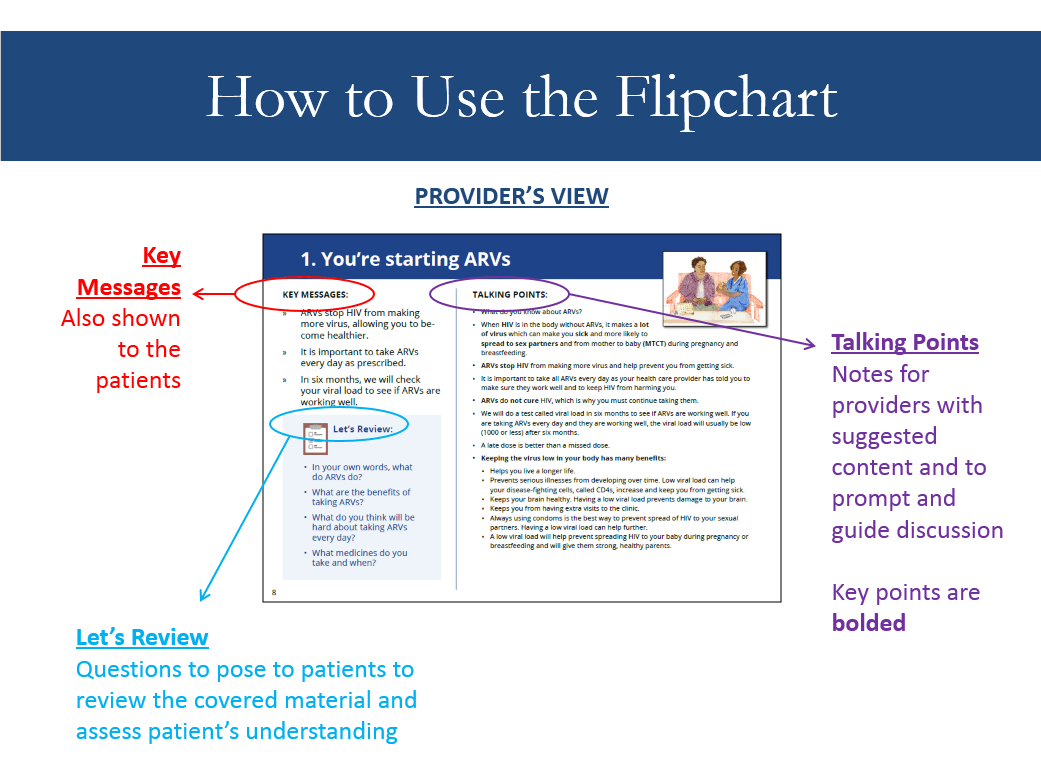“What can happen when your viral load is high?”
“What would be good about a low viral load?”
“How important do you think it is for your long-term health?”
These are a few of the reflection questions from the flipchart for working with adults living with HIV, part of the new Viral Load Toolkit created by ICAP and the Centers for Disease Control and Prevention (CDC).
ICAP and CDC developed this package to empower health care workers with tools and job aids to improve understanding of viral load testing and increase treatment adherence among their patients. They are designed to be adapted to specific contexts.
The flipcharts are designed for three patient age groups: adults, adolescents, and children—with the last providing advice for parents and caregivers of young children living with HIV. These materials and a range of other tools are currently available in English, with translations coming soon in French, Portuguese, and Swahili; adult and adolescent flipcharts will also be available in Russian.
The toolkit can be downloaded free of charge from the ICAP website.
The full list of toolkit resources is as follows:
- Training Curriculum
- Flipcharts on Viral Load Monitoring and Enhanced Adherence Counseling
- Tools and Job Aids including the Enhanced Adherence Plan Tool
ICAP’s website also includes a library of country-specific tools adapted to those contexts.

“Regular viral load testing is important to show patients that their ART (antiretroviral treatment) is working, or to discover whether the patient is missing doses or needs a change in regimen,” said Dr. Tanya Ellman, clinical officer at ICAP. “These tools use open-ended questions, affirmation, reflective listening, and summary statements—called ‘OARS’ techniques—to engage patients in conversation and problem-solving about managing their health. This evidence-based motivational interviewing approach supports behavior change and can enhance the effectiveness of other interventions aimed at improving adherence.”
The flipcharts are meant to be used in “table tent” format, with one side facing the patient (featuring a large illustration of a situation or action and some key messaging points) and one side facing the provider (with more detailed key messaging, talking points, and review questions to ensure patient understanding). Each pair of pages covers a specific topic in the patient visit, with provider instructions at key points to document information or make an evaluation, such as recording the number of missed doses or determining the category of treatment adherence.
The flipcharts address a variety of scenarios, including when a patient begins ART and receives viral load test results. For example, if the patient’s viral load is high, the provider will display a card with a person forgetting to take their medication, and illustrations depicting resistant virus. The provider is encouraged to use non-judgmental language—“I am glad you came to get your viral load test results; now we can help you work towards a low viral load”—and remind the patient that high viral load means HIV is making more virus in their body, which may be because they are not taking antiretrovirals (ARV) as instructed or because the virus is resistant. The flipcharts guide adherence assessments for those with high viral load through discussing challenges they may face taking ARV, including individual, household, and institutional or community barriers to treatment adherence, and exploring possible strategies to overcome them.

The training curriculum includes eight modules—each with a facilitator’s guide, slides and notes—and a training schedule that spaces the modules over approximately one-and-a-half days. Some of the modules contain activities such as facilitator demonstrations of key interactions or role-play sessions for training participants.
“We believe that these resources will help equip and empower health care providers to support their patients through the various stages of managing HIV,” said Dr. Andrea Howard, clinical and training unit director at ICAP. “Effectively communicating the importance of regular viral load testing and good adherence to treatment is essential for improved outcomes for patients on ART and this innovative toolkit really helps get the message across to recipients of care.”








